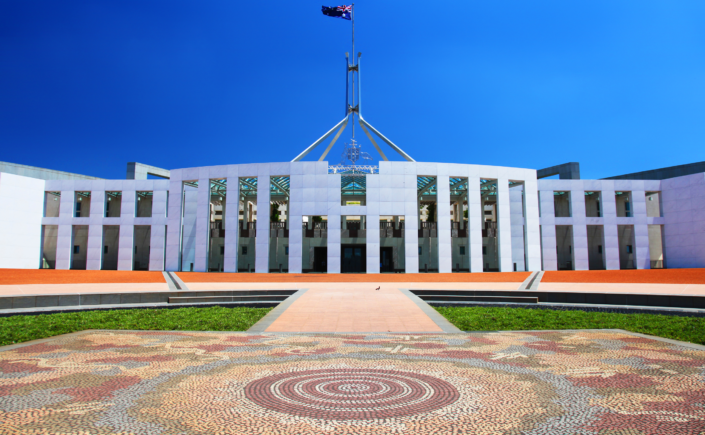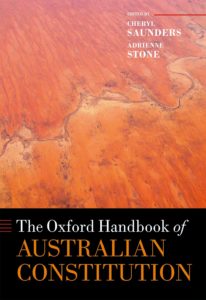The Australian Constitution is distinctive in many ways. These are explored below; for further reading, we suggest the The Oxford Handbook of the Australian Constitution. One feature of obvious comparative interest is the lack of constitutional rights protection. In contrast to constitutions elsewhere, the Australian Constitution contains no preamble, no explicit statements of value, and no Bill of Rights. The closest it comes to express rights protection is a small handful of scattered provisions that variously require property to be acquired on “just terms”, mandate trial by jury for indictable federal offences, protect aspects of freedom of religion, and prohibit discrimination on the basis of state residence.
The Australian Constitution thus offers an admittedly context-dependent test case on whether, and if so how, rights can adequately be protected under an entrenched constitution that, effectively, deals with governmental structures alone. To that question, Australian constitutional history and practice offers an instructive, if imperfect, set of answers. Collectively, they present Australia as an example of what may be described as modified political constitutionalism. Rights are protected by participation in a constitutionally-prescribed system of representative government, a constitutional structure in which power is constrained, separated, and federally divided, and entrenched constitutional oversight by courts. Four aspects may be highlighted, as detailed below.
First, rights are protected through and under Australia’s constitutionally-prescribed system of representative and responsible government. Indeed, most rights in Australia have been secured in this way. In the absence of constitutional protection against discrimination, Australia has a long-established framework of State and federal legislation precluding discrimination on the bases of race, sex, disability and age. The issue of the lawfulness of abortion, resolved judicially by reference to constitutional rights in the United States, for instance, has been largely resolved in Australia by legislation in its States and territories. Likewise, the issue of the lawfulness of euthanasia, resolved judicially in Colombia, Canada, and earlier this year, India, has been largely left to the political processes of the Australian States. The right to same sex marriage, judicially secured in, for instance, South Africa, the United States, and, most recently, Taiwan, was, at long last, secured in Australia by the passage of federal laws last year, following a survey of popular opinion.
Second, the High Court has derived from Australia’s constitutional structure implied limits on power that function similarly to rights. From provisions in the Australian Constitution that require legislators be “directly chosen by the people”, the High Court has implied a requirement of universal adult suffrage. From provisions that establish a “system of responsible and representative government”, the High Court has implied a freedom of political communication. Whilst those implications do not directly protect rights, they limit the reach of potentially rights-curtailing laws. Thus, the High Court has applied the suffrage requirement to strike down a federal law that would have disenfranchised prisoners irrespective of length of sentence, and, more recently, applied the freedom of political communication to strike down sweeping anti-protest prohibitions in a State law.
Third, rights receive some protection from a constitutional separation of federal judicial power, with implications also for the State sphere. This principle has, for instance, been applied by the High Court to strike down some (though not all) laws that have prescribed judicial involvement in liberty-depriving preventative detention and “control order” schemes.
Fourth, Australia’s federal structure raises the possibility of the protection of rights at the sub-national level. Legislative charters of rights have been adopted in the State of Victoria and the Australian Capital Territory, and will shortly be adopted in the State of Queensland. The Victorian Charter requires, for instance, that public authorities consider and act consistently with enumerated human rights, a requirement that is judicially enforced.
To balance this generally positive picture, significant negative examples should be noted as well.
One concerns the rights of non-citizens. Australian immigration law and policy involves the indefinite detention of asylum seekers and refugees, irrespective of the age of detainees or the length or severity of detention. These arrangements highlight the absence of a Bill of Rights: it is doubtful that the system would comply with, for instance, a constitutionally-entrenched right to liberty. The system also highlights the obvious limits of political participation as a guarantor of the rights of non-participants such as non-citizens, and the limits of the separation of judicial power principle, with which the High Court has repeatedly found aspects of the system consistent.
Another example concerns Indigenous Australians. The gap in constitutional rights protection is vividly illustrated by the 2007 federal government “intervention” into indigenous communities in the Northern Territory in response to allegations of child abuse. The “intervention” involved the deployment of several hundred federal military personnel to those communities, and the suspension of federal racial discrimination laws. It is doubtful that this policy could have complied with a constitutionally-entrenched right of equality. The “intervention” also highlights the obvious limits of political representation as a guarantor of minority rights, and the fragility of anti-discrimination laws compared with constitutionally-entrenched rights.
The Australian Constitution thus offers a level of rights protection that is greater than might be expected in the absence of extensive constitutional rights, but less than a constitutional Bill of Rights might be expected to provide. In comparative terms, it shows that, in Australia at least, a form of modified political constitutionalism can provide a significant measure of rights protection, although in a form that is indirect, patchy and fragile. Insights that might be drawn for other countries from the Australian experience should take other aspects of the Australian context into consideration as well, for which the Oxford Handbook of the Australian Constitution now offers a wide-ranging and up-to-date source.
The launch of The Oxford Handbook of the Australian Constitution will be held at the Melbourne Law School on 25 May at 5 pm.


Leave a Reply